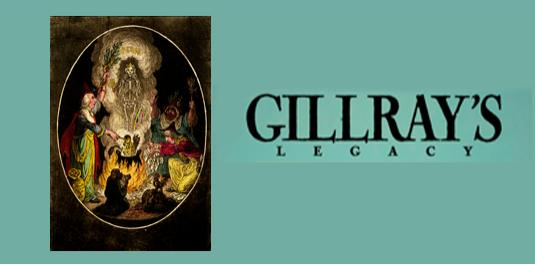Gillray’s Legacy

September 15, 2004 - December 10, 2004
Reading Room Gallery
27 W. 17th Avenue Mall
Columbus Ohio
Gillray’s Legacy coincides with the 2004 Festival of Cartoon Art. Celebrating Georgian England’s greatest caricaturist as part of a twenty-first century conference focusing on censorship, self-censorship and editorial control may seem far-fetched. During an election year at a time of heightened national and international concerns, it is, however, most appropriate to remember that James Gillray was neither restrained nor genteel with his art. Some of the works in this exhibit would not be printed in a newspaper, and several others would draw angry letters to the editor.
In eighteenth century Britain , as Diana Donald notes, “No licensing of presses nor prior censorship impeded the circulation of these frequently abusive, scurrilous and volatile productions [graphic satires]. They were gestural, functioning as an assertion of defiant independence and protest against government which would have been unthinkable in most other European countries…” She continues by noting that “Foreign observers…were stunned by the apparently reckless way in which caricaturists ridiculed and vilified the nation’s leaders, and took this as indicative of the political freedoms enjoyed by the British people.”
The political and social prints that were popular in Georgian England sometimes served as samples for printers in the Colonies who also wanted to criticize George III and politicians on this side of the Atlantic. On occasion, they became more than an inspiration when a Colonial engraver “adapted” a design from England without crediting the source. The British legacy of unfettered graphic commentary provided the roots of cartooning in the New World.
Designs by Gillray from the collections of The Ohio State University Cartoon Research Library in this exhibition are supplemented by reproductions of his work courtesy of the Library of Congress, Art Institute of Chicago, and Draper Hill. They represent two decades of his social and political satire. In addition, the Hale Scrapbook is displayed as an example of how one family used engravings for amusement. Items in the Hale Scrapbook were originally fixed in place with red sealing wax and they were moved from page to page as different people rearranged the book’s contents to suit themselves. Scrapbooking was a common practice: William Makepeace Thackeray remembered that in his grandfather’s generation, “…there would be in the old gentleman’s library two or three old mottled portofolios, or great swollen scrap-books of blue paper, full of the comic prints of grandpapa’s time…How savage the satire was — how fierce the assault — what garbage hurled at opponents — what foul blows were hit… Fancy a party in a country-house now [1854] looking over Wooward’s facetiae, or some of the Gilray [sic] comicalities, or the slatternly Saturnalia of Rowlandson!”
The idea that engravings were a form of entertainment is important in our understanding of the works in this exhibition. Just like today, people in Georgian England enjoyed a good joke at the expense of politicians.

